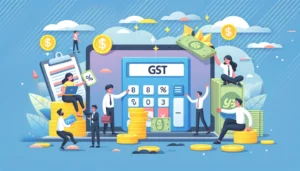Everything You Need to Know About GST Compensation Cess
- 20 Sep 24
- 10 mins

Everything You Need to Know About GST Compensation Cess
- Who Must Collect GST Compensation Cess?
- Which Goods Are Subject to Compensation Cess?
- How to Utilise Input Tax Credit (ITC) for Compensation Cess?
- How to Calculate Compensation Cess?
- How Is Compensation Cess Distributed to the States?
- Challenges in Implementing Cess in India
- Recent Amendments to the Cess and Their Implications
- The Bottom Line
Key Takeaways
- GST Compensation Cess is levied on specific goods and services in addition to GST, with businesses responsible for collecting and remitting it to the central government.
- Goods like tobacco, luxury vehicles, and aerated drinks are subject to compensation cess, with varying rates based on product categories.
- Input tax credit (ITC) can be used to reduce compensation cess liability, though it cannot be used to offset other GST liabilities like CGST, SGST, or IGST.
- The cess is distributed to states to compensate for revenue loss due to the shift to the GST regime, calculated using a projected growth model.
- Recent amendments have extended the GST compensation cess till 2026, with revisions to rates on goods like cars and tobacco to support state revenue.
The Goods and Services Tax (GST) is an indirect tax imposed by the government on the supply of goods and services. In addition to GST, a GST compensation cess is levied on specific products, requiring taxpayers to pay an extra amount. Discover who is responsible for collecting this cess and remitting it to the Central Government, as well as the goods that have been subject to this compensation cess since its introduction in 2017.
Who Must Collect GST Compensation Cess?
Excluding exporters and composition taxpayers, all other taxable persons involved in the supply of selected goods and services will collect compensation cess. This will also cover the compensation cess applicable to certain goods imported into India.
However, if a taxpayer pays compensation cess on exports, he/she can claim its refund. The taxpayers collecting compensation cess need to remit it to the Central Government of India, which distributes it to the state governments.
💡If you want to pay your GST with Credit Card, then download Pice Business Payment App. Pice is the one stop app for all paying all your business expenses.
Which Goods Are Subject to Compensation Cess?
The different goods and their respective cess rates are specified under the GST (Compensation to States) Act, 2017, as amended from time to time, and are detailed below:
| Goods | GST Compensation Cess |
| Cut tobacco | 0.14R per unit |
| Unmanufactured tobacco (with lime tube) – featuring a brand name | 0.36R per unit |
| Unmanufactured tobacco (without lime tube) – with a brand name | 0.36R per unit |
| Branded tobacco refuse | 0.32R per unit |
| Tobacco extracts and essence bearing a brand name | 0.36R per unit |
| Tobacco extract and essence not bearing a brand name | 0.36R per unit |
| Filter khaini | 0.56R per unit |
| Jarda scented tobacco | 0.56R per unit |
| Cheroots and Cigars | 21% or ₹4,170 per thousand, whichever higher |
| Cigarillos | 21% or ₹4,170 per thousand, whichever is higher |
| Cigarettes containing tobacco excluding filter cigarettes, of length not more than 65mm | 5% + ₹2,076 per thousand |
| Cigarettes containing tobacco apart from filter cigarettes, of length more than 65mm and up to 75mm | 5% + ₹3,668 per thousand |
| Filter cigarettes of length (including the length of the filter, the length of the filter being 11 millimetres or its actual length, whichever is more) not exceeding 65 millimetres | 5% + ₹2,076 per thousand |
| Filter cigarettes of length (including the length of the filter, the length of the filter being 11 millimetres or its actual length, whichever is more) exceeding 65 millimetres but not exceeding 70 millimetres | 5% + ₹2,747 per thousand |
| Filter cigarettes of length (including the length of the filter, the length of the filter being 11 millimetres or its actual length, whichever is more) exceeding 70 millimetres but not exceeding 75 millimetres | 5% + ₹3,668 per thousand |
| Cigarettes of tobacco substitutes | ₹4,006 per thousand |
| Cigarillos of tobacco substitutes | 12.5% or ₹4,006 per thousand whichever is higher |
| Smoking mixtures for pipes and cigarettes | 290% |
| Branded ‘hookah’ or ‘gudaku’ tobacco | 0.36R per unit |
| Tobacco used for smoking ‘hookah’ or ‘chilam’ commonly known as ‘hookah’ tobacco or ‘gudaku’, not bearing a brand name | 0.12R per unit |
| Other water pipe smoking tobacco not bearing a brand name | 0.08R per unit |
| Other smoking tobacco bearing a brand name | 0.28R per unit |
| Other smoking tobacco not bearing a brand name | 0.08R per unit |
| Homogenised or reconstituted tobacco, bearing a brand name | 0.36R per unit |
| Chewing tobacco (without lime tube) | 0.56R per unit |
| Chewing tobacco (with lime tube) | 0.56R per unit |
| Preparations containing chewing tobacco | 0.36R per unit |
| Pan masala (gutkha) containing tobacco | 0.61R per unit |
| All goods, other than pan masala containing tobacco ‘gutkha’, bearing a brand name | 0.43R per unit |
| All goods, other than pan masala containing tobacco ‘gutkha’, not bearing a brand name | 0.43R per unit |
| Snuff | 0.36R per unit |
| Preparations containing snuff | 0.36R per unit |
| Coal, ovoids, briquettes, and similar solid fuels manufactured from lignite, coal, whether or not agglomerated, excluding jet, peat (including peat litter), whether or not agglomerated | ₹400 per tonne |
| Aerated waters | 12% |
| Lemonade | 12% |
| Others | 12% |
| Motorcycles with engine capacity exceeding 350 cc | 3% |
| Aircraft (including helicopters, etc.) for personal use | 3% |
| Yacht and other vessels for pleasure or sports | 3% |
| Motor vehicles for the transport of not more than 13 persons, including the driver | 15% |
| Motor vehicles, excluding ambulances, three-wheelers and vehicles of engine capacity not exceeding 1500cc and of length not exceeding 4000 mm, with both spark-ignition internal combustion reciprocating piston engine and electric motor as motors for propulsion or with both compression-ignition internal combustion piston engine [diesel-or semi diesel] and electric motor as motors for propulsion | 15% |
| Petrol, liquefied petroleum gas (LPG) or compressed natural gas (CNG) driven motor vehicles of engine capacity not exceeding 1200cc and of length not exceeding 4000mm. | 1% |
| Diesel-driven motor vehicles of engine capacity not exceeding 1500cc and of length not exceeding 4000mm. | 3% |
| Motor vehicles of engine capacity not exceeding 1500 cc | 17% |
| Motor vehicles of engine capacity exceeding 1500 cc other than motor vehicles specified against entry at S. No 52B | 20% |
| Motor vehicles of engine capacity over 1500cc, popularly known as Sports Utility Vehicles (SUVs) including utility vehicles. | 22% |
How to Utilise Input Tax Credit (ITC) for Compensation Cess?
Taxpayers can utilise input tax credit of the cess to reduce the liability of compensation cess arising due to the outward supply of goods and services. In other words, taxpayers can subtract taxes paid on purchases (input tax) from the output tax (taxes paid on finished goods) to reduce their GST liability.
For instance, you are a taxpayer paying ₹400 on raw material purchases with GST payable of ₹600. Then you can claim an input tax credit of ₹400, and pay the remaining ₹200 as outward tax. As a taxpayer, you can utilise ITC to pay GST cess. However, you cannot utilise it to pay CGST, SGST and IGST.
How to Calculate Compensation Cess?
GST compensation cess is an additional amount imposed over and above the GST on goods or services supply. The rate of cess applicable is provided under Section 15 of the CGST Act, 2017, which taxpayers need to pay for selected goods or services supplied.
How Is Compensation Cess Distributed to the States?
The Central Government distributes GST compensation cess to the manufacturing-heavy states. This ensures compensation for loss of revenue due to a consumption-based tax regime implemented at the state level. In accordance with Section 7(C) of the GST Act, 2017, the total compensation payable during a financial year to a state is the difference between the projected and actual revenue that a state collects.
Step-by-Step Guide to Calculating the Compensation Cess Amount
Here are the steps to calculate the compensation cess payable:
Step 1: The revenue for the fiscal year 2016-17 is taken as the base revenue for the state under consideration.
Step 2: A 14% annual growth rate is assumed for the concerned state for a five-year period over which the GST cess applies. With this as the base, the projected revenue for the concerned state is calculated.
Step 3: During the transition period, the compensation amount is provisionally released at an interval of two months.
Challenges in Implementing Cess in India

Here are the challenges in implementing cess in India:
- Complex Calculations
The imposed cess varies based on the tax amount, tax rate, tax base, exemptions, deductions and rebates that might apply to various taxpayers. This makes cess calculation complex and often prone to errors. In addition, cess rates change from time to time, making the calculations complicated.
- Compliance Burden
Taxpayers often need to maintain separate records, file returns separately and pay additional dues for the cess. They might need to pay multiple cesses such as health and education cess, coal cess or road and infrastructure cess, which leads to a higher compliance burden for taxpayers. The cost of compliance is high, making it difficult for taxpayers to adhere to tax guidelines.
- Refund Mechanism
Cess is a non-refundable payment over and above taxes. This often creates challenges for taxpayers in terms of cash flow management. Exporters, who cannot get a cess refund can be subject to challenges due to cess implementation. Non-refundable cess additionally creates a cascading effect of taxation. This increases the burden of tax on final goods and services due to a levy of cess at multiple stages.
Recent Amendments to the Cess and Their Implications
The GST compensation cess was scheduled to conclude on 30th June, 2022. However, the Indian government extended it to 31st March 2026. The objective of the extension is to ensure financial support to the Indian states that have been subject to revenue loss due to GST implementation.
The government adjusted the cess rates on goods like motor cars, tobacco and liquor in Budget 2023-24. It aims to generate revenue amounting to ₹50,000 crore with the newly introduced cess rates. The following are the revised cess rates for a few of the goods:
| Goods | Percentage Increase | Revised Cess Rate |
| Mid-sized Cars | 2% | 17% |
| Large Cars | 5% | 22% |
| SUVs | 7% | 25% |
| Tobacco and Tobacco Products | 10% | 20% |
| Liquor | 5% | 15% |
The Bottom Line
The GST compensation cess rates vary significantly based on the products and tax rates. It further varies based on exemptions, rebates and deductions that taxpayers are subject to. As a result, the calculation of cess is complex and often erroneous making it complicated for taxpayers. Adhering to revisions in cess guidelines can help taxpayers comply with the regulations despite revisions in cess rates.
 By
By 

















